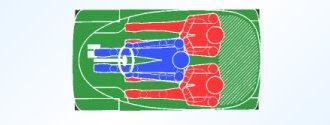 Gordon Murray is still being very secretive about his upcoming small city car, codenamed T.25. As a report published this week demonstrated, journalists granted an interview with Murray are reduced to feeling the car through its dust cover, lest they uncover its charms before time.
Gordon Murray is still being very secretive about his upcoming small city car, codenamed T.25. As a report published this week demonstrated, journalists granted an interview with Murray are reduced to feeling the car through its dust cover, lest they uncover its charms before time.
Via that CBCNews Canada report, we learn that the steering wheel is “not in a conventional place”, something we suspected from the moment we saw photos of the foil-wrapped prototype’s swooping screen pillars.
“The internal layout is absolutely unconventional,” Murray told CBCNews. “You don't get in and out of it the normal way. You don't sit in it the normal way ... And certainly the shut lines on the body would give that away.”
All of which confirms that we should take at face value Murray’s recent patent application for a “compact seating arrangement”. The application asserts that Murray has dreamed up an unconventional layout, and in filing for a patent he has asked for legal recognition of its uniqueness, so that rivals will have to pay a fee to use the same ideas in their own compact cars until the patent expires. That’s assuming the application is approved and the patent granted. The Patent Office could decide the innovation is too obvious, or not original enough - more of which later.
So how will the T25 work? How will it cram four adults into a footprint smaller than a two-seat Smart? Well, it won’t. The layout Murray wants to patent seats three adults, not four: one driver in a central position, plus two passengers seated behind and either side of the driver; the trio forming a triangle with its point facing forward. As the patent application goes on to explain, the height and the shapes of the three seats allow the occupants to be squashed together to a remarkable extent. Everyone will sit more upright than is the norm in a car, rear-passenger knees will slip into voids cut in the driver’s seat back. Passenger legs will stretch out either side of the driver as far as the front wheel-arches.
Well, it won’t. The layout Murray wants to patent seats three adults, not four: one driver in a central position, plus two passengers seated behind and either side of the driver; the trio forming a triangle with its point facing forward. As the patent application goes on to explain, the height and the shapes of the three seats allow the occupants to be squashed together to a remarkable extent. Everyone will sit more upright than is the norm in a car, rear-passenger knees will slip into voids cut in the driver’s seat back. Passenger legs will stretch out either side of the driver as far as the front wheel-arches.
The arrangement has lots of advantages for a small car - it can be short and narrow and yet reasonably comfortable for all three occupants. The driver, in particular, will enjoy a footwell free of the intrusion and offsetting that so often blights the small car experience. The driver might get the odd dig in the ribs from a passenger’s knee, but all-round visibility will be great - better than in a Toyota iQ carrying three adults, where the front passenger sits further forward than the driver, compromising safety at junctions.
The snag is that the central driver’s seat might be tricky to sit in without a crouch and a scramble from the door, since it sits a couple of feet further inboard from the sills than is normal. Murray’s solution is to create headroom by removing part of the roof along with the door - hence his coyness about shutlines. The other goal Muray has for his miniaturised runabout is nose-to-the-kerb parking, and the patent document acknowledges that each side door will need to open upwards, in Lamborghini scissor fashion or Delorean gullwing mode, or will need to slide out of the way like a van’s side door, taking a part of the roof with it.
The other goal Muray has for his miniaturised runabout is nose-to-the-kerb parking, and the patent document acknowledges that each side door will need to open upwards, in Lamborghini scissor fashion or Delorean gullwing mode, or will need to slide out of the way like a van’s side door, taking a part of the roof with it.
Interestingly, we’ve seen much the same seating layout proposed by Heuliez for its promised three-seat electric car, the Friendly. Its doors do indeed slide completely out of the way, along with a piece of the roof - and a piece of the floor too. What’s more, documents released by Heuliez show a very similar seating layout to the one proposed by Murray. In fact Heuliez’s computer-generated images would not look out of place alongside Murray's text.
What’s more, documents released by Heuliez show a very similar seating layout to the one proposed by Murray. In fact Heuliez’s computer-generated images would not look out of place alongside Murray's text.
All of which makes us wonder whether Murray will succeed in getting his patent.
However, we suspect that Murray has a few more tricks up his sleeve to reveal yet. After all, the sketches of the T.25 released at the start of the project (and at the one year mark) seem to be deliberately designed to throw us all off the scent, showing details that we now know are not going to feature in the car - such as a front-mounted engine. It’s reasonable to suppose that his patent application is far from Murray’s final word on the T.25’s innovations.
Unpeeling the Gordon Murray T25
22 May 2009
Read more about: Gordon Murray Heuliez iQ small cars T.25



